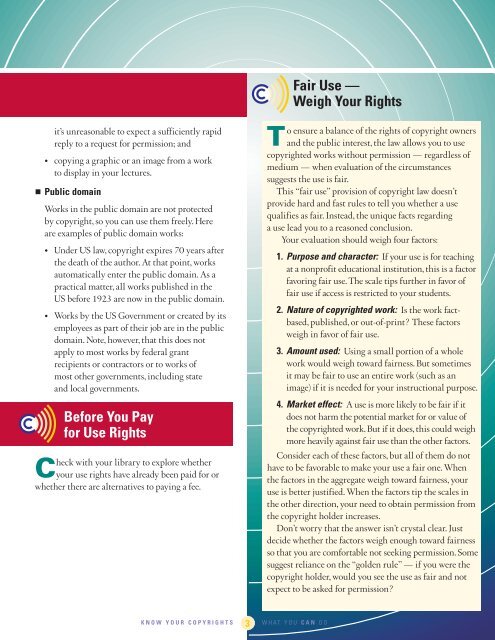Know Your Copy Rights What You Can Do
You also want an ePaper? Increase the reach of your titles
YUMPU automatically turns print PDFs into web optimized ePapers that Google loves.
Fair Use —<br />
Weigh <strong><strong>You</strong>r</strong> <strong>Rights</strong><br />
it’s unreasonable to expect a sufficiently rapid<br />
reply to a request for permission; and<br />
• copying a graphic or an image from a work<br />
to display in your lectures.<br />
Public domain<br />
Works in the public domain are not protected<br />
by copyright, so you can use them freely. Here<br />
are examples of public domain works:<br />
• Under US law, copyright expires 70 years after<br />
the death of the author. At that point, works<br />
automatically enter the public domain. As a<br />
practical matter, all works published in the<br />
US before 1923 are now in the public domain.<br />
• Works by the US Government or created by its<br />
employees as part of their job are in the public<br />
domain. Note, however, that this does not<br />
apply to most works by federal grant<br />
recipients or contractors or to works of<br />
most other governments, including state<br />
and local governments.<br />
Before <strong>You</strong> Pay<br />
for Use <strong>Rights</strong><br />
Check with your library to explore whether<br />
your use rights have already been paid for or<br />
whether there are alternatives to paying a fee.<br />
To ensure a balance of the rights of copyright owners<br />
and the public interest, the law allows you to use<br />
copyrighted works without permission — regardless of<br />
medium — when evaluation of the circumstances<br />
suggests the use is fair.<br />
This “fair use” provision of copyright law doesn’t<br />
provide hard and fast rules to tell you whether a use<br />
qualifies as fair. Instead, the unique facts regarding<br />
a use lead you to a reasoned conclusion.<br />
<strong><strong>You</strong>r</strong> evaluation should weigh four factors:<br />
1. Purpose and character: If your use is for teaching<br />
at a nonprofit educational institution, this is a factor<br />
favoring fair use. The scale tips further in favor of<br />
fair use if access is restricted to your students.<br />
2. Nature of copyrighted work: Is the work factbased,<br />
published, or out-of-print? These factors<br />
weigh in favor of fair use.<br />
3. Amount used: Using a small portion of a whole<br />
work would weigh toward fairness. But sometimes<br />
it may be fair to use an entire work (such as an<br />
image) if it is needed for your instructional purpose.<br />
4. Market effect: A use is more likely to be fair if it<br />
does not harm the potential market for or value of<br />
the copyrighted work. But if it does, this could weigh<br />
more heavily against fair use than the other factors.<br />
Consider each of these factors, but all of them do not<br />
have to be favorable to make your use a fair one. When<br />
the factors in the aggregate weigh toward fairness, your<br />
use is better justified. When the factors tip the scales in<br />
the other direction, your need to obtain permission from<br />
the copyright holder increases.<br />
<strong>Do</strong>n’t worry that the answer isn’t crystal clear. Just<br />
decide whether the factors weigh enough toward fairness<br />
so that you are comfortable not seeking permission. Some<br />
suggest reliance on the “golden rule” — if you were the<br />
copyright holder, would you see the use as fair and not<br />
expect to be asked for permission?<br />
KNOW YOUR COPYRIGHTS WHAT YOU CAN DO<br />
3



